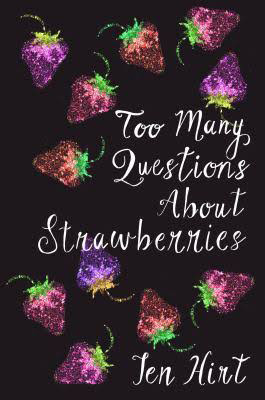‘Too Many Questions About Strawberries’ by Jen Hirt
 Brandi Pischke’s cover art of sparkly strawberries invites us into Jen Hirt’s book of poems, Too Many Questions About Strawberries. Can we expect a romp through a garden or farmer’s market? Not necessarily, though Hirt’s book takes us through fun, rowdy poems, as well as challenging ones that do, in some cases, concern plant life.
Brandi Pischke’s cover art of sparkly strawberries invites us into Jen Hirt’s book of poems, Too Many Questions About Strawberries. Can we expect a romp through a garden or farmer’s market? Not necessarily, though Hirt’s book takes us through fun, rowdy poems, as well as challenging ones that do, in some cases, concern plant life.
Let’s start with “Why not malachite for resurrection.” In this poem, an apartment’s appeal is heightened because its back steps are perfect for a container garden.
 Brandi Pischke’s cover art of sparkly strawberries invites us into Jen Hirt’s book of poems, Too Many Questions About Strawberries. Can we expect a romp through a garden or farmer’s market? Not necessarily, though Hirt’s book takes us through fun, rowdy poems, as well as challenging ones that do, in some cases, concern plant life.
Brandi Pischke’s cover art of sparkly strawberries invites us into Jen Hirt’s book of poems, Too Many Questions About Strawberries. Can we expect a romp through a garden or farmer’s market? Not necessarily, though Hirt’s book takes us through fun, rowdy poems, as well as challenging ones that do, in some cases, concern plant life.
Let’s start with “Why not malachite for resurrection.” In this poem, an apartment’s appeal is heightened because its back steps are perfect for a container garden. Those plans are foiled by:
apt. #5’s unshorn poodle
[ . . . ] his ratty chinfur
stained with discount kibble and bad
ideas for the potted fern on the top step,
a fern best knocked down and dug out, andyou will note the time of ferndeath.
Which leaves said renter to speculate: “why not malachite for resurrection, / for the nine fiddleheads better than apostles that / rise in lime ambition.”
A good example of Hirt’s more forceful work is a prose poem titled “Have two: Chatsworth Estate, Derbyshire England, May 2012”:
Having left London to see what was demolished in 1920, which was the world’s largest greenhouse. Having found in its place a hedge maze choked with strollers and ice cream vendors. [ . . . ] Having the great glasshouse dynamited. Having the war to blame.
Hirt, a prolific writer and an educator at Penn State Harrisburg, draws on even more historical events and people in her well-researched pieces. A prominent wildlife ecologist plays a part in “Foxes I’ve seen by now,” Aldo Leopold “shooting his last wolf” and then moving “to stand over her green eyes and his regret and this privilege of weapons and wealth.”
Hirt also manages to master the emotional as well as the historical. For those of us who’ve had to dispose of items once belonging to deceased loved ones, Hirt perfectly captures the feelings of sadness in “Elegy after the Jeweler’s.” In this case, she’s selling her mother’s jewelry and summons us to feel: “What it’s like to be told / your watch cogs are worn as Appalachia / and not worth fixing.”
The jeweler in question then asks how she’s heard about him from “anywhere else” besides the sign in his window. She responds:
I want to tell him
other things I’ve heard about
from anywhere else,Where farmers hang roadkill
from paw-paws for flies to pollinate
their carrion flowers.Where if you donate your body
to science there is no funeral fee
but also no funeral home.
Of course it’s definitely a cliché to save the best for last, but the closing entry, the abecedarian poem “The A, B, C’s of 1, 2, and 3: An Inventory of the Overstock” is a delight to read. The clue to subject matter in these alphabetically arranged stanzas lies in the poem’s subtitle. For example, here’s what Hirt does with the letter E:
Extravagant comes from the Latin “vagari,” to wander. Hit up the Google images for “extravagant lace” and it’s all wedding dresses. Try something that seems like it can’t be extravagant, like the Amish. Turns out you can order an extravagant Amish gazebo . . . for your wedding.
Move on to O:
Oodles is a word of unknown origin, like massacre. Doodles, Noodles, Poodles, Toodles – I think it slipped from those words. I think it massacred the consonants.
And let’s not forget J: “Junk, most of it.”
Hirt’s collection actually begins with the title poem, “Too Many Questions About Strawberries.” We’re first at a farmer’s market where she ticks off questions from shoppers: “inquiries about ripeness and sweetness and origin, [ . . . ]. // You’d think they were as expensive as rubies.”
Then it switches to a u-pick farm with this glowing visual:
white plastic colander like a roller rink of garnets tilted toward my hand and while we eat the embryos of fragrance (why do strawberries smell so good?) the sunset pours all the world’s Bordeaux to celebrate how the only answer to questions about
strawberries is yes.
With that in mind, I urge readers to also say yes to this book.
Review by Valerie Wieland




